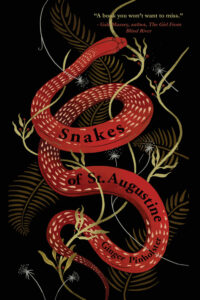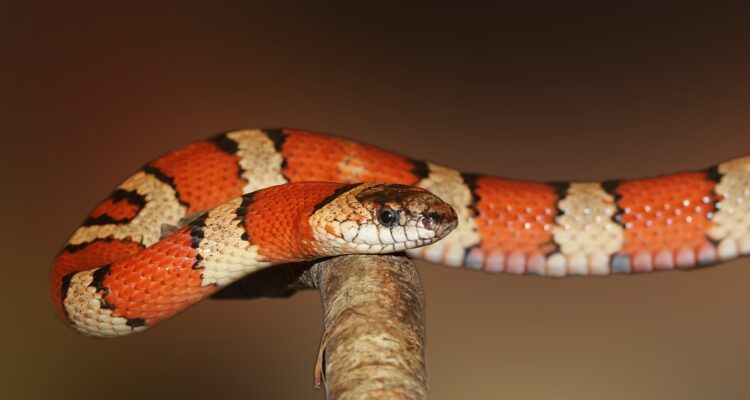The theft of Trina Leigh Dean’s beloved snakes – including a rare Eastern indigo named Unicorn, Banana Splits the yellow ball python, and Bandit the banded king snake – coincides with the disappearance of a troubled young man named Gethin Jacobs. While his sister Serena searches for him, she gains an unlikely accomplice: Jazz, a homeless community college student. Meanwhile, Trina’s friend Fletch, a burnt-out cop, scours St. Augustine, Florida, for the stolen snakes. Fletch’s quest puts him on a dangerous collision course with Gethin, raising questions about community, family, and the power of compassion.
 We caught up with author Ginger Pinholster today to chat about Snakes of St. Augustine, available now for pre-order. After the interview, check out the discussion questions for your next book club event. Welcome, Ginger!
We caught up with author Ginger Pinholster today to chat about Snakes of St. Augustine, available now for pre-order. After the interview, check out the discussion questions for your next book club event. Welcome, Ginger!
What inspired you to write Snakes of St. Augustine?
Snakes of St. Augustine was inspired by a real-life tragedy involving the late Jason Harrison. A 38-year-old man living with psychosis, Harrison was killed by police officers in Dallas in 2014 after his mother asked for help getting him to a hospital. When I saw the police bodycam video of the killing, I found it deeply sad and disturbing. It made me think about the people in my own life, including my late brother, who have struggled with being different. In writing my book, I learned that people living with psychosis are rarely a threat to others, and in fact, they are far more likely to be mugged or raped, compared with the rest of us. Yet, discrimination and stigma too often turn those with mental illness into “the others.” And, although we now have a 9-8-8 hotline that people can call when they have a mental health crisis, too many police units still lack the training or personnel to safely deal with people who have neurodiversity – people like the late Jason Harrison.
How much of this story was drawn from real life?
This novel is fictional, and so it’s largely a product of my imagination. With that said, as a former teacher once told me, “It all comes from somewhere” – that is, deeply buried memories and life events tend to wind up in the stories that we write. In my case, losing my younger brother to mental illness, and subsequently finding a partner who has neurodiversity, clearly influenced me as I was writing Snakes of St. Augustine. When I met my current partner, although I didn’t realize it at the time, I was probably subconsciously thinking, “Okay, here’s someone I can help, even if I wasn’t able to help my brother.” All of those feelings certainly wound up in the novel.
The Florida setting feels so essential to this story. How did you go about capturing the state’s unique wacky charm?
Many works of Southern fiction have historically treated the physical setting as another character in the story… maybe because of the transition from farmland to industrial land uses, in so many places. As a writer, I feel a need to preserve rapidly vanishing places, at least in the mind’s eye. I love to read immersive descriptions of physical settings, and to do that, I try to engage all five senses.
For her workshops, the wonderful ecology writer Janisse Ray has developed a free-writing exercise called, “I’ve seen it with my own eyes.” The purpose of the exercise is to write a scene – moment to moment, through the senses, by showing rather than telling. This is how I try to write about story settings. Florida is a wild and beautiful place, and there’s no end to the state’s weirdness, such as monkeys colonizing a state park, or giant pythons invading the Everglades, or alligators inexplicably strolling through the ocean surf. Plenty of fodder for a fiction writer.
What do you hope readers will take away from this story?
“Snakes of St. Augustine” is fundamentally about the power of community to help people who are living on the margins of our society. One of the characters in the book, Jazz, describes feeling as if he is “a homeless, potentially dangerous ghost, out of focus and wavy around the edges.” In other words, he feels invisible because of his homelessness and his obvious neurological differences. I hope that readers might look again at people like Jazz – people who are different, or on the margins – and consider the ways in which we are all similar, and all worthy of inclusion and compassion.
What’s next for you?
I’m currently revising a third novel set in New Mexico. It’s a dual-timeline historical novel. It tells the story of a wounded warrior, Jemi, who is fighting to regain her confidence, in parallel with a nursing home resident, Rose, who is struggling to have her Native American heritage verified. The historical story delves into a shameful period of American history when, sadly, many Native American children were removed from their families. I’ve also begun to outline a fourth novel – I can’t share details yet, but suffice it to say, there are sea turtles.

CLICK HERE FOR BOOK CLUB QUESTIONS
 Ginger Pinholster likes to say that turtles find her. A volunteer member of Florida’s Volusia Turtle Patrol, she earned her M.F.A. degree from Queens University of Charlotte and a B.A. from Eckerd College. Her first novel, City in a Forest, won a Gold Royal Palm Literary Award from the Florida Writers Association in 2020. A resident of Ponce Inlet, she serves as vice president for communications at Embry-Riddle Aeronautical University in Daytona Beach. Previously, she was the long-time chief communications officer for the American Association for the Advancement of Science, where she became an elected Fellow. Long ago and far away, she was a journalist. To learn more, visit: www.gingerpinholster.com
Ginger Pinholster likes to say that turtles find her. A volunteer member of Florida’s Volusia Turtle Patrol, she earned her M.F.A. degree from Queens University of Charlotte and a B.A. from Eckerd College. Her first novel, City in a Forest, won a Gold Royal Palm Literary Award from the Florida Writers Association in 2020. A resident of Ponce Inlet, she serves as vice president for communications at Embry-Riddle Aeronautical University in Daytona Beach. Previously, she was the long-time chief communications officer for the American Association for the Advancement of Science, where she became an elected Fellow. Long ago and far away, she was a journalist. To learn more, visit: www.gingerpinholster.com


